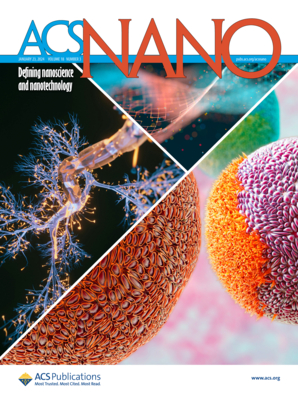IF 15.8
1区 材料科学
Q1 CHEMISTRY, MULTIDISCIPLINARY
引用次数: 0
摘要
水硫电池有望实现高性能、低成本的能量存储。然而,由于低价硫氧化还原(S0/S2-)的负电位[与标准氢电极(SHE)相比,E0 = -0.51 V]和高价硫氧化还原(S2O32-/S4O62-或 S4+/S0)的低放电容量(∼300 mA h g-1),它们的能量密度受到低电池电压的限制。在此,我们通过引入 Cu2+ 和 Zn2+ 离子介质,开发出一种可逆的碱性硫阴极,其氧化还原电位高于 0 V vs SHE,高于低价硫氧化还原电位,比容量高达 1340 mA h g-1。此外,所提出的可充电碱性硫电池的工作电压高达约 1.1 V,反应动力学迅速,即使在高达 10 A g-1 的高电流密度下也能保持稳定。深入表征和 DFT 计算显示,碱性硫电化学遵循六电子转换反应 S ↔ CuS ↔ ZnS + Cu2O ↔ Cu,能量密度为 1168 W h kg-1,功率密度为 8110 W kg-1。这项研究为水性硫电化学提供了新的见解,并为实现高能量密度水性电池提供了新的选择。本文章由计算机程序翻译,如有差异,请以英文原文为准。

Reversible Alkaline Sulfur Cathode Based on Six-Electron Electrochemistry for Advanced Aqueous Sulfur Batteries
Aqueous sulfur batteries are promising for high-performance and low-cost energy storage. However, their energy density is limited by low battery voltages due to the negative potential [E0 = −0.51 V vs standard hydrogen electrode (SHE)] of low valent sulfur redox (S0/S2–) and low discharge capacity (∼300 mA h g–1) of high valent sulfur redox (S2O32–/S4O62– or S4+/S0). Herein, we develop a reversible alkaline sulfur cathode via introducing Cu2+ and Zn2+ ion mediators, exhibiting a redox potential above 0 V vs SHE, which is higher than low valent sulfur redox and high specific capacity of 1340 mA h g–1. Furthermore, the proposed rechargeable alkaline sulfur batteries achieve a high operating battery voltage of approximately 1.1 V and rapid reaction kinetics, sustained even at high current densities of up to 10 A g–1. In-depth characterization and DFT calculations reveal that the alkaline sulfur electrochemistry follows a six-electron conversion reaction S ↔ CuS ↔ ZnS + Cu2O ↔ Cu, delivering an energy density of 1168 W h kg–1 and a power density of 8110 W kg–1. This work offers insights into aqueous sulfur electrochemistry and shows an alternative to achieving high energy density aqueous batteries.
求助全文
通过发布文献求助,成功后即可免费获取论文全文。
去求助
来源期刊

ACS Nano
工程技术-材料科学:综合
CiteScore
26.00
自引率
4.10%
发文量
1627
审稿时长
1.7 months
期刊介绍:
ACS Nano, published monthly, serves as an international forum for comprehensive articles on nanoscience and nanotechnology research at the intersections of chemistry, biology, materials science, physics, and engineering. The journal fosters communication among scientists in these communities, facilitating collaboration, new research opportunities, and advancements through discoveries. ACS Nano covers synthesis, assembly, characterization, theory, and simulation of nanostructures, nanobiotechnology, nanofabrication, methods and tools for nanoscience and nanotechnology, and self- and directed-assembly. Alongside original research articles, it offers thorough reviews, perspectives on cutting-edge research, and discussions envisioning the future of nanoscience and nanotechnology.
 求助内容:
求助内容: 应助结果提醒方式:
应助结果提醒方式:


